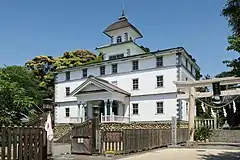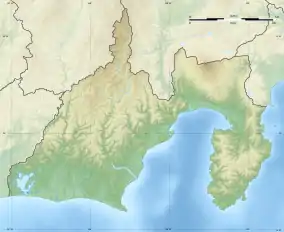Mitsuke School
The Former Mitsuke School (旧見付学校, kyū-Mitsuke Gakkō) is a surviving Giyōfū-style Meiji period school building located in the city of Iwata, Shizuoka in the Tōkai region of Japan. The building was designated a National Historic Site of Japan in 1996.[1]
| former Mitsuke School | |
|---|---|
旧見付学校 | |
 Old Mitsuke School front facade | |
 Old Mitsuke School  Mitsuke School (Japan) | |
| General information | |
| Architectural style | Giyōfū |
| Location | Iwata, Shizuoka |
| Country | Japan |
| Coordinates | 34°43′39″N 137°51′25″E |
| Completed | 1875 |

Overview
Built in 1875, the Mitsuke school vies with the Former Nakagomi School in Saku, Nagano for the title of the "oldest western school building in Japan". As with the Nakagomi School, the wooden school building is an example of the Giyōfū-style of the early Meiji period, a pseudo-Western style of architecture which incorporates both western and Japanese elements. The building originally had three stories on a stone foundation, but was enlarged in 1883 with the addition of a two-story tower. The tower contained a drum, rather than a bell, for telling the time.
It closed as a school in 1922, and was thereafter used for a number of purposes, including a teacher's training college, martial arts dojo, girl's high school sewing classroom, Imperial Japanese Army hospital, and municipal hall, until it finally reopened in 1992 as an education museum.
On the north side of the former school is the Iwata Bunko, which was founded by the local kokugaku scholar Ōkubo Takuhisa in 1864 on land donated by the neighboring Ōmikunitama Jinja Shinto shrine. This library contained over 5000 volumes of works pertaining the kokugaku studies, and is housed in a kura-style building. The Iwata Bunko also protected under the same national historic site designation as the former Mitsuke School.
References
- "旧見付学校附磐田文庫" (in Japanese). Agency for Cultural Affairs.
External links
![]() Media related to Former Mitsuke School at Wikimedia Commons
Media related to Former Mitsuke School at Wikimedia Commons